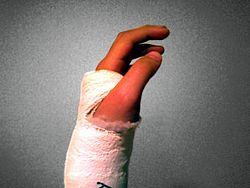People over the age of 50 who have suffered a fracture because of a slip or trip play a central role in making sure they get proper care to prevent a future fracture, a new study has found.
The findings are important because previous efforts to improve care for bone health after one of these fractures have had limited success.
Dr. Dorcas Beaton, lead author of the study and director of the Mobility Program Clinical Research Unit at St. Michael’s Hospital, found that people with what are known as fragility fractures who understood their potential risk for another fracture were more likely to do something about it.
Having bone mineral density testing done was not as important as the patient understanding the test results, the study found. Past and acquired knowledge about bone health and osteoporosis was also pivotal.
The study appears online in the journal Osteoporosis International.
Half of all women over the age of 50 and one in five men over 50 will have a fracture after falling from standing height or lower. Having one such fracture doubles a person’s risk of having another. But there are ways to reduce the risk.
Dr. Beaton said that unless patients understand there is a risk, they fall through the cracks and are less likely to discuss the issue with their family physicians.
Dr. Beaton leads a team at St. Michael’s that is evaluating the Fracture Clinic Screening Program, part of Ontario’s Osteoporosis Strategy. This program has placed coordinators in the busiest fracture clinics around the province to try to help patients connect with their primary care providers in an informed way. Patients can then make decisions about care to reduce the risk of another fracture.
Dr. Beaton’s study looked at the role a fracture patient’s knowledge and self-perceived need that bone health could be an issue had on his or her likelihood of having a risk assessment done and treatment initiated. Previous research has shown that getting treatment can significantly reduce the risk of breaking a bone again.
For Dr. Beaton’s study, research participants from 37 fracture clinics around Ontario completed a survey about their perception and knowledge of osteoporosis with the bone health coordinators in those clinics.
Dr. Beaton found that most patients did not perceive themselves to have a bone health issue and therefore would be less likely to follow up with their physicians to discuss their options. Most had no idea that a fracture that has occurred after the age of 50 and from a slip, trip or fall from a low height could be the first indicator of a bone health issue – which they can do something about.
The treating practitioners (usually family physicians) appeared more likely to order a bone density test and preventative care if the patient was informed and aware that he or she might have an underlying bone health issue, the study found.
“Treatment decisions lie with the primary care physician or nurse practitioner and the patient to decide upon. Our goal is to facilitate evidence-based and well- informed decision-making.” Dr. Beaton said. “It seems that the patient’s awareness is currently central to the process, to even getting the discussion started.”
There are many steps in preventing the next fracture – talking to a physician, getting tested and assessed for personal fracture risk, and beginning treatment, which could include Vitamin D supplements, lifestyle changes or in some cases taking drugs such as bisphosphonates.
The study found that patients are pivotal to each of these steps and their awareness of their own bone health made a big difference to whether these actions took place.
The Fracture Clinic Screening Program, run by Osteoporosis Canada, has seen more than 40,000 Ontarians since 2007.
Internationally, there are not enough physicians administering preventative care regarding fragility fractures. It is estimated only about 20 per cent of fracture patients have anyone talk to them about bone health that might have contributed to their current fracture and the risk of future fractures.


